Day 2 of a three day Autumn Tour in Norfolk today. We planned to spend the morning down in the Brecks and then return to North Norfolk for the afternoon. It was rather cloudy and grey all day, a bit brighter around the middle of the day, but it stayed dry and the much lighter winds were both a blessing and a hindrance!
On the drive down to the Brecks, a Red Kite over the fields next to the road was a nice addition to the trip list. Otherwise it was a fairly uneventful journey, until we got down to the area where the Stone Curlews are gathering. Before we even got to the layby, we could see a good number from the road as we passed, in the edge of the field just beyond the hedge. There is nowhere to stop here so we continued on to the place where we could park.
Unfortunately, the bulk of the Stone Curlews we had seen from the car were out of view from here today, over a ridge in the field. Fortunately, we could still see a couple of Stone Curlews nestled down in the field. We got the scope out and scanned and found there were actually six here, though only the heads of some of the others were visible. We got the scope on the most obvious and closest bird and had a good look at it. We could see its bright yellow iris, when it opened it eyes, and its black-tipped yellow bill.

We had a good look at the first Stone Curlew, then two of the others stood up from where they were hiding down in the low-growing crop, so we turned the scope on them.
There were a few Red-legged Partridge in the field too and a pair of Egyptian Geese flew over. A brief glimpse of a hawk disappearing away over the trees suggested something more exciting until it came back over the field and we could see it was just a young female Sparrowhawk flying in an odd fashion, with deep and powerful wingbeats more like a display flight.
There have been some more Stone Curlews in another field further on, so we decided to go and check those out, and then if need be come back and try to see the ones we had seen from the road earlier. As we edged in slowly along the path, we realised that some of the Stone Curlews were very close to us, closer than normal, hidden in the vegetation. We froze. A small number of the birds flew, but thankfully landed again just a little further back. Some of the others walked a short distance away, but most of them stayed put.
We got one of the Stone Curlews in the scope, and had a good look at it taking turns. Gradually, over the next half an hour, we were able to edge out into a position from where we could all see some of the birds. They were settled now, untroubled by our presence at a discrete distance, and we had some truly amazing, frame-filling views of them here.
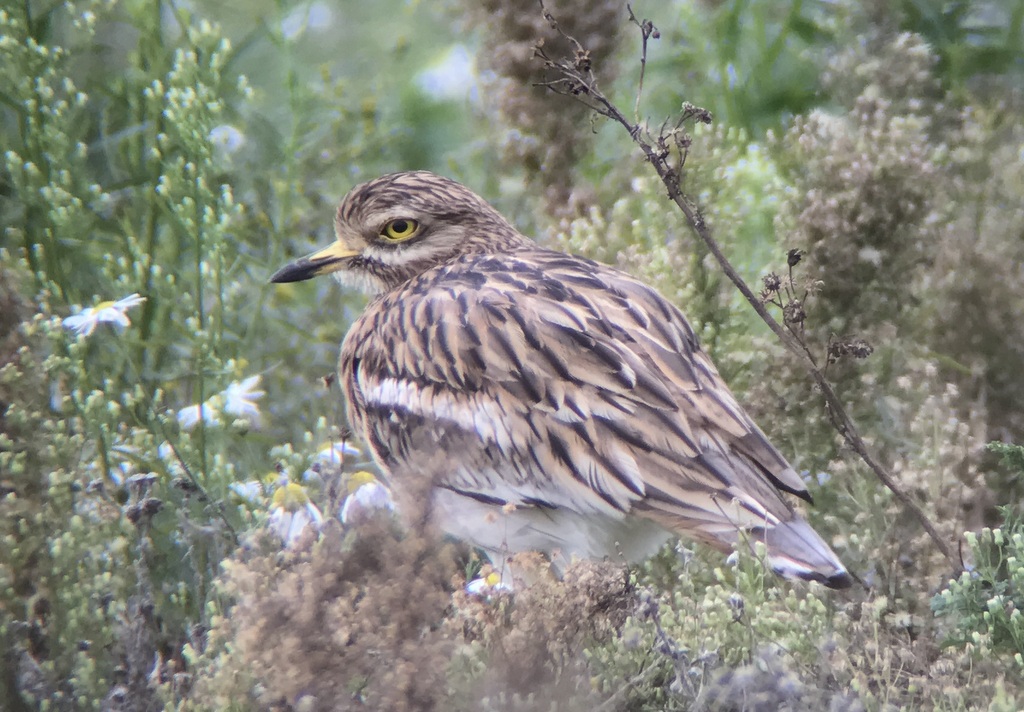
Scanning back and forth over the vegetation, we realised we could see more and more birds, with several hiding or sitting down so only the tops of their heads were visible. At first we could only see about 15-20, but by the end we had managed to count at least 41 Stone Curlews here visible at any one time. An amazing sight!
A flock of Linnets were feeding down in the weedy vegetation too, and kept flying round calling. There were some pig fields not far away and when we made our way round there we could see lots of gulls out amongst the pigs. They were almost entirely Lesser Black-backed Gulls, but looking through them carefully we managed to find a single adult Yellow-legged Gull as well as one or two Herring Gulls, in with them.
It had been an amazingly successful start to the morning and, as we were down in the Brecks now, we thought we would see if we might be able to see a Goshawk. This is not the best time of year to see them, but the juveniles in particular do like to come up and play on windy days. Unfortunately this morning the wind had dropped much more than forecast, and there was also no warmth from the sun which was stuck behind the clouds.
As we drove back along the road, we could see all the other Stone Curlews in the first field we had passed – there were at least another 30 here, but we couldn’t stop. We carried on to a spot on higher ground which overlooks an area of forest. There were lots of Lapwings and Starlings out on the cultivated field in front of the trees. Several Mistle Thrushes kept dropping down from the trees to the field to feed, before flying back up again. In the trees, we could see lots of finches, including a couple of small flocks of Siskin.
At first there were not even any Common Buzzards up in the air over the trees. However, we could see a mass of hirundines. Through the scope, we could make out that they were mostly House Martins out over the forest, but along the edge of the trees and over the fields by the road, there were more Swallows. A small numbers of Swallows came across the field in front of us, seemingly on their way west. Clearly these birds were just stopping off here on migration, heading off to Africa for the winter.
Gradually a few Buzzards started to circle up. They weren’t gaining much height today though. One landed in the top of a pine tree. Another drifted over the field behind us, mobbed by a large flock of Jackdaws.
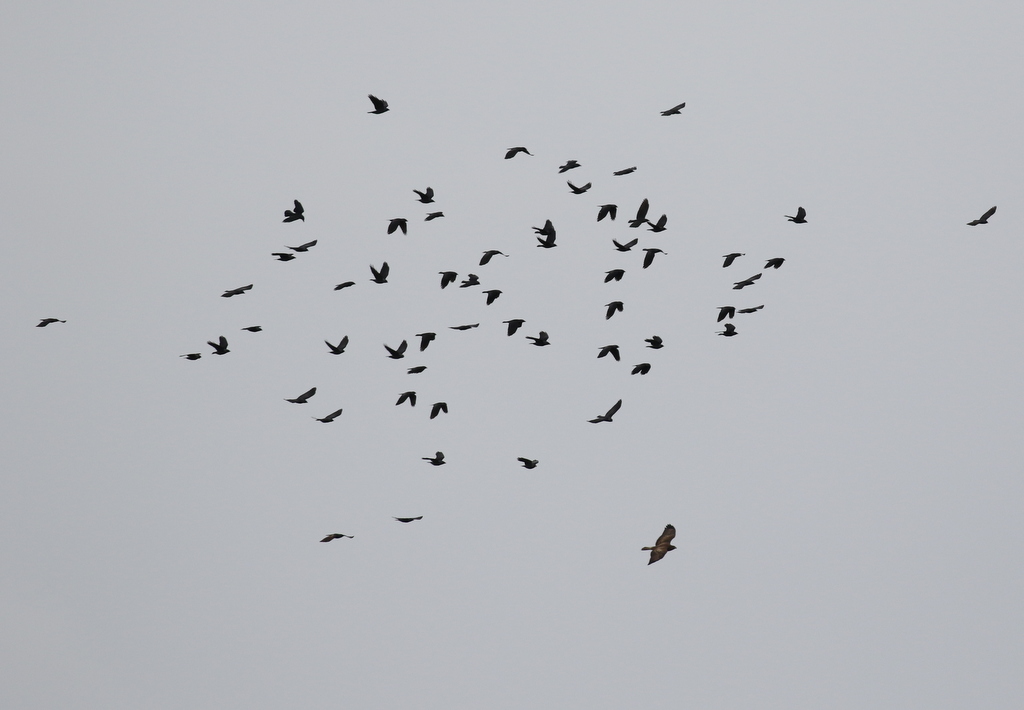
Eventually a juvenile Goshawk appeared above the wood in the corner. Unfortunately, it was only visible for a few seconds as it flew over the tops, not long enough for everyone to get onto it, before disappearing behind a line of trees. Despite scanning either side in the hope it would re-emerge, it didn’t come back up again. A Sparrowhawk was more obliging, circling up amongst all the hirundines before flying across and dropping back down into the forest.
We tried another spot a little further on. There were lots of Common Buzzards up now, and a Red Kite too, but still no further sign of any more Goshawks. It was not the best day for raptor watching, so we decided to head back up to North Norfolk. During a quick stop in Wells to use the facilities, we heard Pink-footed Geese calling and looked up to see a flock of 36 high over the town, heading west. Presumably more birds just returning here for the winter.
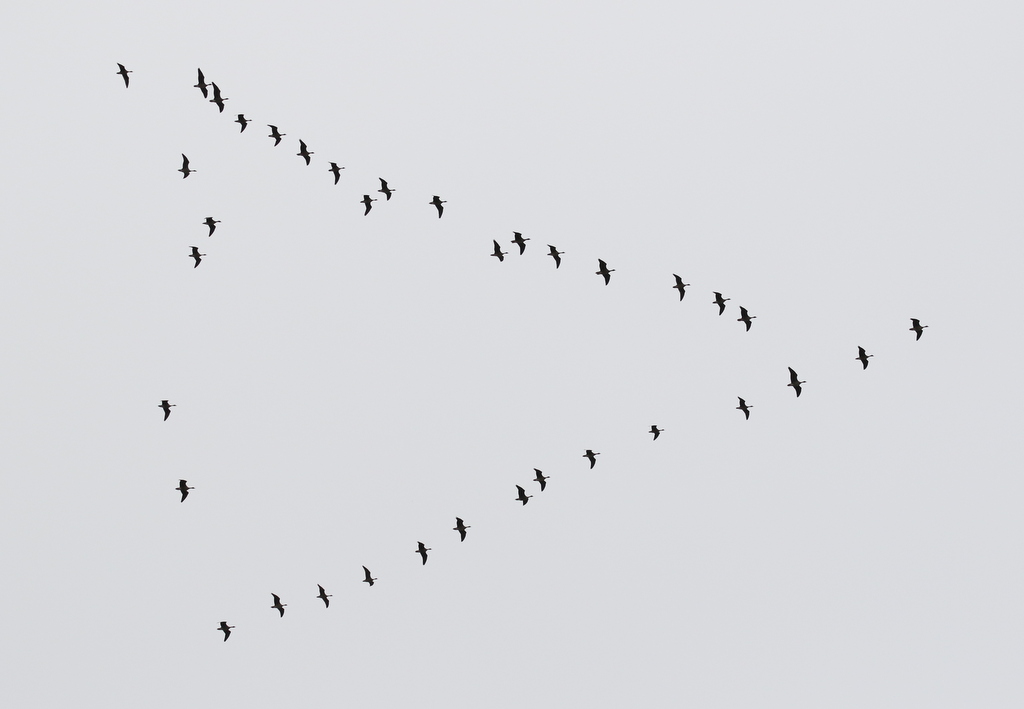
We stopped for lunch at Stiffkey, overlooking the saltmarsh. A distant Red Kite was circling out over East Hills and we could see several Curlews, Redshank and Little Egrets were scattered around in the vegetation in front of us. A large flock of Golden Plover flew up a little to the east of us, flying round for a minute or so before disappearing back down into the vegetation.
A single Spoonbill appeared out on the far edge of the saltmarsh, before dropping down out of view to feed in one of the small pools. At times we could just see its head appear, but eventually it climbed out again and we got a good look at it through the scope.
After lunch, we headed along the coast to Blakeney. With a hint of a few migrants in today, we had a quick look around Friary Hills first. It was very quiet in the trees here, with just a Great Spotted Woodpecker calling in trees. As we walked back round along the bottom path, a Chiffchaff was calling in the hedge. Just beyond it, we came across a tit flock, moving fast through the bushes. A grey warbler disappeared round the back before we got a look at it, and despite following the tits along the hedge, all we could see with them now were a few finches.
Walking out along the seawall, a Greenshank was on the mud on the edge of the harbour channel, but was flushed by a couple out walking and disappeared downstream, behind the saltmarsh. We had a better view of a Little Egret, fishing in one of the smaller muddy channels by the path, jiggling its feet in the mud in front of it, trying to flush out something to eat.
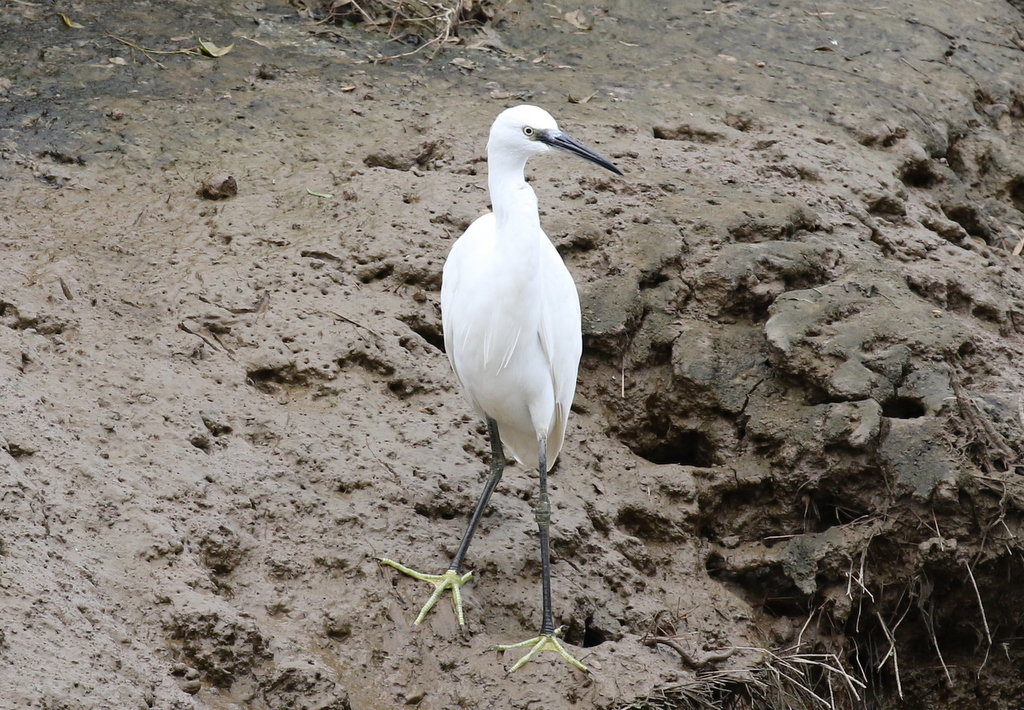
When we got to the corner of the seawall, we stopped to scan the harbour. We could see lots of Curlew and Redshank on the mud closer to us, but most of the other waders were much further out, around the pools in the bottom of the harbour. Through the scope, we could see Oystercatchers and godwits, one or two Grey Plover and a Ringed Plover and several Turnstones.
Looking out across the Freshes the other side, two juvenile Marsh Harriers were flying back and forth over the reeds, chocolate brown with a contrasting paler head. They were joined by a paler female which came up from the reeds and circled with them for a minute of two before landing on a gate post.
Then the male Marsh Harrier flew in from the harbour behind us. It circled over the rest of the family and looked like it might be preparing for a food pass, despite the fact we couldn’t see anything in its talons. The two juveniles up circled expectantly below it, but it clearly wasn’t here to feed them and gradually drifted off. The juveniles followed, one of them gaining height and swooping down at the male from above. Possibly it was cross that it hadn’t been fed! Eventually the male lost interest and flew back out again towards the harbour.
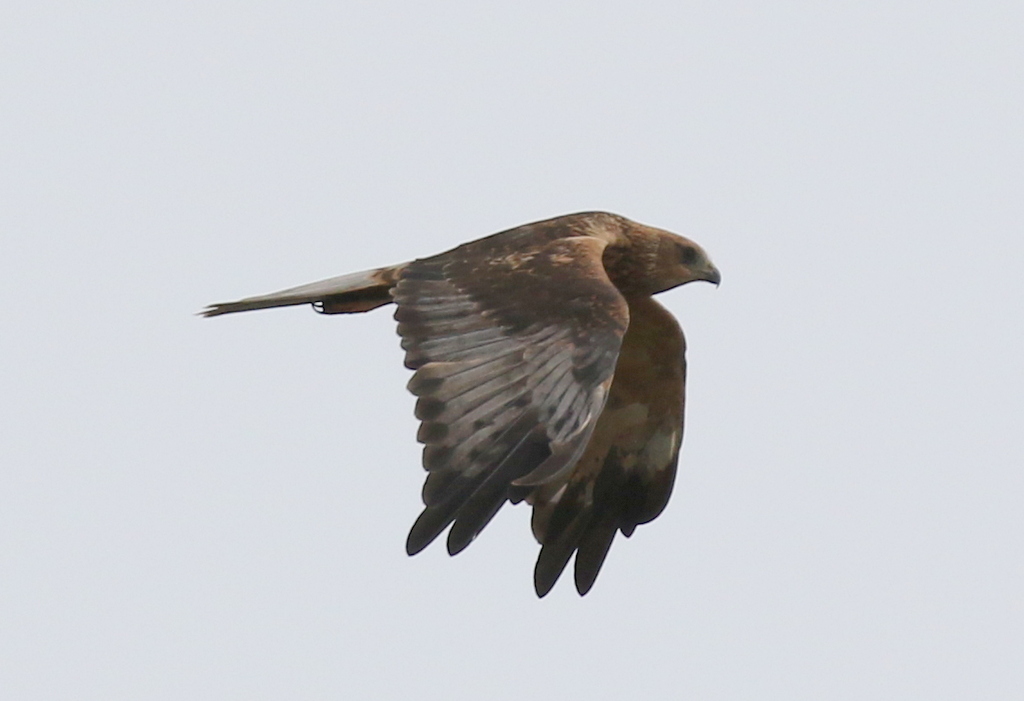
We walked back on the path across the grazing marsh. There were not many birds here today, but we did spot a Stock Dove which flew in and landed with a couple of Wood Pigeons out on the grass.
Stiffkey Fen was our last planned stop of the day. The bushes and brambles by the path were quiet at first today, just a couple of Blue Tits. Then we heard Bullfinches calling in the thicker sallows and looking carefully through the foliage, we could just make them out feeding in the back.
When we got to the point where you can see across the brambles to the Fen beyond, we immediately spotted the Spoonbills. There were twenty of them today, mostly asleep, but we could see a pair preening each others heads and necks. When you have a bill as long as that, you need a bit of help to reach some places! When a juvenile Marsh Harrier flew over, all the Spoonbills woke up and we could see there was a mixture of adults with yellow-tipped black bills and juveniles with shorter dirty fleshy bills.
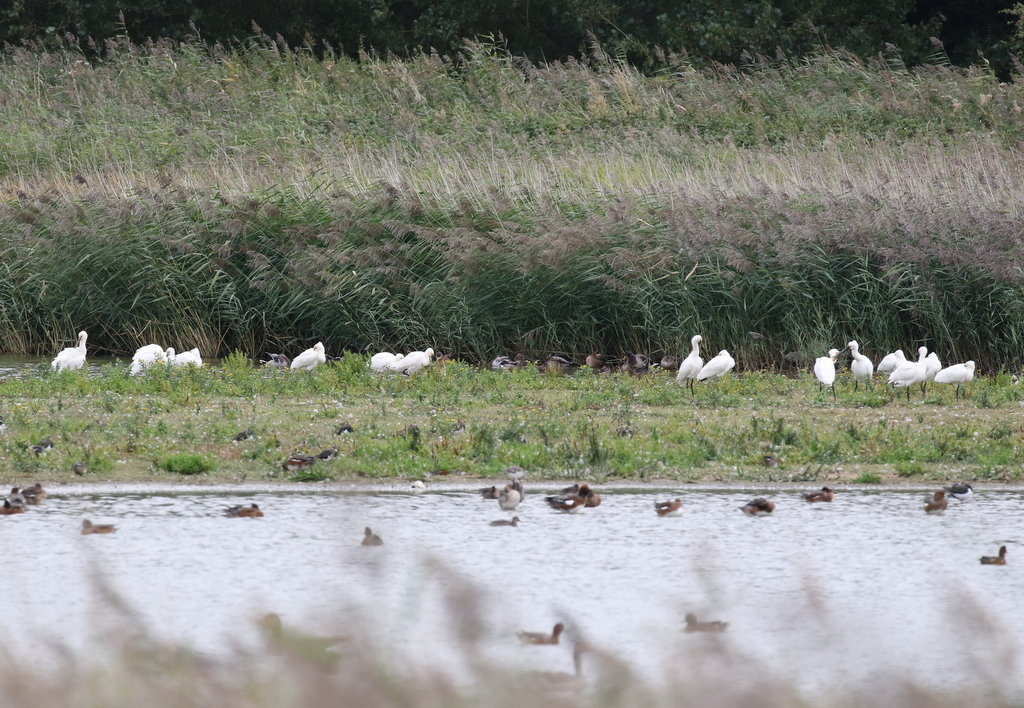
Over at the back, against the reeds, we could see a single Avocet feeding. Most of them have left already now, for the winter. A Green Sandpiper was right over the back too and a couple of Greenshank flew in calling. When we heard a cacophony of honking just behind us, a wave of Greylags flew in very low over our heads from the fields and dropped down onto the Fen. Quite an experience!
From up on the seawall, we had a better view of the Spoonbills through the scope. As well as all the Greylags now, there were lots of ducks out on the Fen – mainly Wigeon, Teal and Shoveler, plus a good number of Pintail. and a couple of Tufted Ducks.
A big flock of Black-tailed Godwits was roosting down on the Fen and we could see several Redshanks and Ruff, in various shapes and sizes, with them. Down along the edge of the mud in front of the closer reeds we could see a couple of Snipe feeding and a second Green Sandpiper with them. More Greenshanks were flying in from the harbour in ones and twos ahead of the rising tide – we were up to seven already now.
Looking out across the harbour, we could see all the seals hauled out on the end of Blakeney Point and on the sandbars opposite. A couple more large flocks of Pink-footed Geese came in off the sea round the end of the Point, flying on west over the saltmarsh towards Wells and Holkham. A Hobby flew low across the harbour, flushing all the birds around the edge as it did so. With the element of surprise gone, it quickly climbed higher and carried on west.
The tide was coming in fast now. A flock of Oystercatchers had gathered on one of the rapidly disappearing shingle spits on the edge of the harbour. On the spit in front, a single Grey Plover was standing with a lone Curlew until a large flock of Grey Plover and Turnstones flew in to join them. Through the scope, we could see the Grey Plovers were in various stages of moult, with more or less of the summer black face and belly remaining.
News came through that a Wryneck had been seen in Wells. This was a much wanted bird for several members of the group, to the point that we had joked each morning about seeing three or four of them! However, it was very much unexpected today, particularly given the persistent westerly winds and the comparative lack of other migrants coming in. We had to go for a quick look on our way, despite having limited time now before we had to be back.
When we got there, we found a couple of people standing in the car park. They hadn’t been able to find it and no one really knew where it had been seen exactly. We had just got out to talk to them when we noticed a bird drop out of the low hedge just a couple of metres from us, down onto the bare dusty ground on the car park verge – the Wryneck!
It flew again immediately, to a thicker area of trees by the car park entrance. We got everybody out and walked slowly over in that direction. There was the Wryneck, down on the ground on a small grassy bank just the other side of the trees. It froze there, looking round, though seemingly undeterred by the camper vans coming in and out of the caravan park between us and it, from where we were standing on the other side of the entrance road.
It wasn’t easy for everyone to get onto at first, despite it being quite close, as it looked just like a branch or small lump of earth in the grass, but finally the whole group were watching the Wryneck. It was a great view of it here.
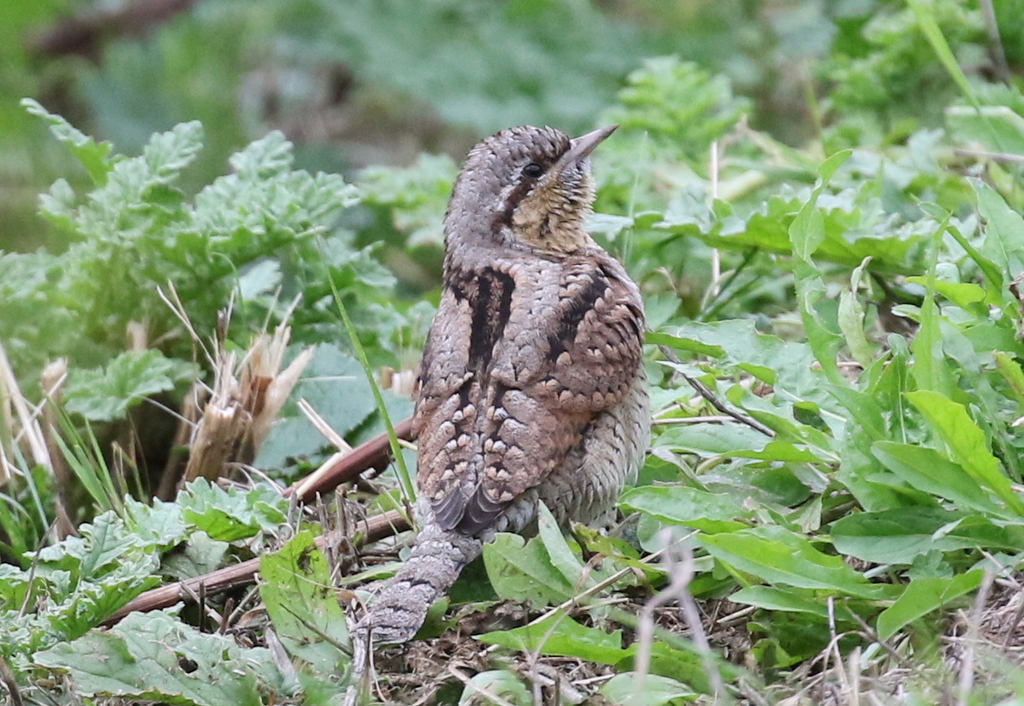
Then a Wood Pigeon flew low across over the bank and spooked the Wryneck, which flew into the bushes nearby. We waited a few minutes, in case it might come straight out again, but it was cloudy and cool and the light was fading now. We really had to get everyone back too, or they would be late for dinner! It was a fantastic – and most unexpected – way to end the day, with a Wryneck.
















